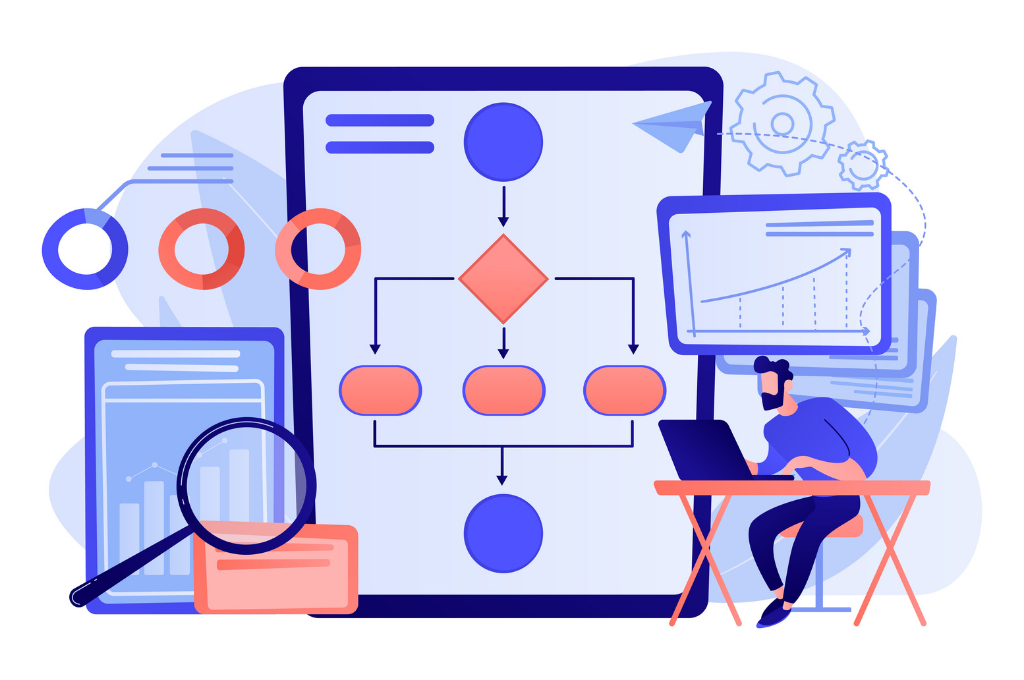With over 80% of the enterprise content unstructured, there is a huge mine of information that enterprises are struggling to fetch insights from. They've been using transactional, master, and analytial data contained in structured data. But a treasure trove of insights are still hidden within the unstructured data.
And this is what businesses need to uncover in order to deliver a seamless and friendly digital customer experience. It can be through the chats your support staff has with the users, how seamlessly pain points in fulfilling a task, email analytics, and even social media.
Every interaction that your customer has with your brand can deliver data that can be used to improve decision making or even improve the overall experience through personalization. So, how can the corporate world deal with this huge repository of unstructured content and convert it into a meaningful resource.
The answer is a robust, efficient, and scalable Enterprise Content Management System.
Choosing the right ECM for your business largely depends on answering questions like “How will you troubleshoot it?” and “How will it help your business?”
The ECM Market is flooded with CMS solutions. Among so many options, several companies continue to prefer Drupal.
Introducing Drupal
Drupal is one of the most powerful and robust content management platforms offering businesses a medium to structure and manage their content. Being a few and open-source software, anyone, be it, individuals, groups of users, or large-scale businesses, can use Drupal to build and manage their website efficiently. Even without any in-depth technical skills.

At its core, Drupal is a CMS. But today, Drupal is lined with so many features and functionalities that it won't be wrong to call it a full-fledged digital experience platform. This enterprise CMS solution allows you to create blogs, websites, online portals, eCommerce platforms, social networking sites, directory sites, intranet sites, and much more. And that too while easily managing their interactions through each touchpoint in their customer journey.
Why Use Drupal As Enterprise CMS Solution?
Businesses usually have one question when it comes to choosing their CMS system, why use Drupal? There are many other software platforms like Magento, Joomla, Salesforce, Sitecore, etc., that offer similar functionalities and features like Drupal.
What makes Drupal stand out from other CMS systems is that it is designed with large-scale projects and multiple users in mind. It can easily handle a number of libraries and even different file types. You can even structure resources based on the models that your organization is following. There should also be some kind of privacy for protecting data despite offering complete collaboration to users.
Written in PHP, one can easily download the Drupal software and start creating their website for all types of content management. From collaborative authoring to management to newsletters to, even more, Drupal allows it all with ease.
Business leaders and expert developers search for a platform that is highly reliable, secure, and flexible to develop powerful applications. They need a well-defined architecture that is integrated with third-party applications to go ahead with web and app development. that is where Drupal comes in.
Drupal helps businesses create real-time enterprise-grade solutions that empower web innovation.
Here are listed Drupal features as a enterprise Web Content Management System.
- Offers Dynamic Content Management
- Ensures scalability
- Completely compatible with enterprise database
- Follows mobile-first approach
- Highly Secure
- Integrates easily with a wide ecosystem of digital marketing technology
- Easy content authoring
- Flexible content architecture
- Support Multisite deployment and multilingualism
Undoubtedly, there are several reasons why Drupal has become a favorite for content management. But why exactly is so popular as enterprise CMS solution. If you are also wondering what made Drupal reach this enviable popularity, here is a breakdown of those reasons.
#1. Drupal Offers Versatility
One of the core reasons why enterprises have been loving Drupal CMS is its versatlity. One can create a number of digital experiences using Drupal. No doubts, its versatility makes it a reliable CMS in many ways.
-
Presentation Layer – It has a very convenient presentation layer for easy and enjoyable authoring with the help of built-in integration. Drupal 8 provides a WYSIWYG-based, integrated editor that comes in very handy to create content rapidly.
-
Multi-Channel Delivery – Drupal’s multi-channel delivery is an ideal feature to reach out to customers with a variety of devices. You can preview the content for any device such as a smartphone and optimize it for speed before posting it.
-
Collaboration – Your web development team has to share content and media for better productivity. Group collaboration, management of user-generated content, and handling activity streams of multiple users are some of Drupal’s best features.
-
Language Compatibility – Your Drupal-managed application provides the facility to download content translations for about 100 global languages. It also allows you to hide or display the content according to the language being used, giving you a responsive web design.
-
Seamless E-commerce Integration – Drupal allows you to integrate eCommerce solutions seamlessly to your enterprise portal. Its eCommerce features include managing product catalogs, shopping carts, orders, and payments.
#2. Integrated and Open-Source Platform
You can judge Drupal’s integration capabilities by the fact that it provides 1800+ themes and 24,000+ free plug-ins to the active development community. It is the only CMS that fulfills all requests of corporate and small business websites, eCommerce sites, social media networks, and blogs. Drupal is the largest open-source content management platform in the world with over 15 million downloads, and nearly 1.14 million websites are currently using Drupal Core. Twitter, for example, has a community of 750,000 Drupal developers. It uses Drupal’s web content management and community capabilities to power “dev.twitter.com,” Twitter's global site for developers.
#3. Scalable & Low Ownership Costs
Drupal is flexible and extendible but with the increasing requests landing on your website, it slows down. Websites can be scaled up successfully if you add complexity in increments. For scalability, the Drupal community supports ‘Pressflow - a branch of Drupal core’ and ‘Varnish - an advanced and fast reverse proxy. Being open-source, Drupal costs a lot less than proprietary CMS tools. Small to medium-scale enterprises that cannot afford high-end development tools can manage their web content efficiently with the free but robust Drupal.

#4. Highly Customizable
Drupal can be customized by adding new features, themes, and the latest updates without the loss of existing data. Enterprises can require a huge range of extensions based on their content needs. Drupal provides this feature with customizations as well. The templates provided by Drupal can be personalized to fulfill business requirements. Drupal customization also includes custom module development, site testing for quality assurance and deployment, optimization, and maintenance.
#5. Drupal Is Highly Secure
Another reason why Drupal is so popular as an enterprise CMS solution is the level of security that it offers. When it comes to enterprise, they have hundreds of users managing content, leads, and more. Not just that, they also collect data of hundreds of thousands of users browsing the site on a daily basis.
Drupal offers complete protection of user data and even prevents spam bots from crawling the website. In fact, industry research has also shown that Drupal has one of the least vulnerability percentage when it comes to online hacking at just 2%.
#6. Drupal Has Several Modules For Enterprise
There are different modules that are offered by Drupal that make it great for enterprises of all industries.
-
PathAuto: This module enables you to automatically generate paths or URLS for different types of content.
-
XML Sitemap: This lets the web crawlers understand the site better and intelligently crawl it for better ranking.
-
Ctools: Managing pages is made easier with the Ctools module, which also leads to better authoring experience.
-
Pathologic: Fixing broken links and directing URLs is a much simpler when you have the Pathlogic module offered by Drupal.
Further, with Drupal 10 releasing, there are a number of new features and functionalities that would be offered by the enteprise CMS solutions platform.
#7. Drupal Offers Multisite Management
One of the biggest reasons why enterprises should use Drupal CMS is because of its multisite management capabilities. Most enterprises have their branches in different locations, languages, markets and more. Adopting multisite architecture allows enterprises to manage hundreds of websites without any downtime or glitch. They can ensure uniformity for branding as it requires a single codebase while meeting the specific needs of users.
Also Read: Everything Enterprises Need To Know About Drupal 8 Multisite
Drupal and the Cloud for Enterprises
Drupal is a robust and efficient CMS. However, when it uses cloud services and tools, its benefits increase tremendously, especially for larger enterprises. You can have a single Drupal core installation in a multi-site environment, without storing it with your application. The application code does not need any modification, but you can upgrade or downgrade the performance of your application by only configuring the Drupal core.

A good example showcasing Drupal’s prowess on the cloud is The Economist. It manages 1.2 million articles and blog posts, digitizes the monthly print magazine, authenticates users with tiered subscription levels across the web and apps, and serves customized homepages to millions of users a day.
Drupal 10 is planned to release in December 2022.
Conclusion
Because of the above-mentioned reasons, it would be appropriate to say that Drupal qualifies as an enterprise content management tool. Its success in your organization will depend on how well-planned the implementation is.
However, as with any new system implementation, for the best results, it is better to start with a simple and basic core and add complexity to the application in small increments over time.
Have you implemented Drupal in your enterprise? What challenges did you face with the implementation? Let us know in the comments below, and thanks for reading!






























